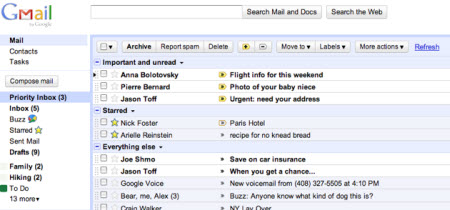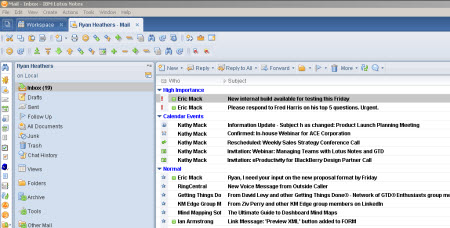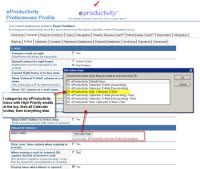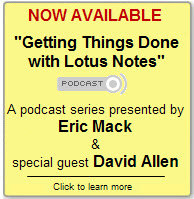I’ve been reading the many articles on the new Gmail Priority Inbox with great interest. People are praising this “innovative” Gmail feature all over the place. And it is pretty cool. But as Alan Lepofsky pointed out, Lotus Notes has had similar inbox categorization features for over a decade. But apparently, few people know that. Or maybe, few people care…
The Lotus Notes categorized inbox provides many of the features that everyone is raving about in Gmail’s release. In Notes, your inbox can sort emails according to high priority marks, calendar invites, and the unwashed masses of regular emails. It’s helpful. If you’re a person who receives critical calendar invites interspersed with stacks of regular emails, it can be a life-saving feature.

Source: TechCrunch

The one feature that the Gmail Priority Inbox provides that’s unique is the learning algorithm that trains itself to know what emails are most important to you. But I can see the value of this feature swinging all over the place. The jury is still out on whether Gmail can accurately predict what's important to me.
Using the Lotus Notes categorized inbox, the only emails in the Important category are one’s that people have sent to you with a high importance mark. So you know that email is there because someone else felt it was important for you to see it. (As a side note, I know people who really dislike how high importance marks let the sender dictate your email processing prioritization. I don’t have a problem with it.)
But with Gmail, what’s considered “Important” is a little more mysterious. There are lots of factors such as who the sender is, the frequency that you open emails from this person, what keywords are in the emails you open the most, and more. You can also click buttons to help train the Gmail importance algorithm.
So I think the value of this feature depends entirely on how accurate it will become over time. If you can trust it to display ALL "important" emails, great. Otherwise, you won’t trust it and you’ll still have to look through your other emails. In that case, it wouldn’t offer anything over what Lotus Notes currently offers.
A GTD Perspective
I also come at this story with a GTD perspective. GTD espouses the principle of making decisions about your email on the front-end. It’s most efficient to process each email once and move it out of our inbox onto its final home in the trash bin, your task list, or a storage location if it’s reference. Reading an email and then leaving it in the inbox is highly inefficient, because then you have to reprocess it each time you look at your inbox.
To use an analogy that I’ve heard along the way and really connect with: “Your email inbox is a highway. It’s not a rest stop”.
Now David Allen, the creator of GTD, wrote a short article addressing if Gmail’s new Priority Inbox was “anti-GTD”:
Having email sorting/filtering would be anti-GTD if you use it to avoid decision-making, but not if it’s just for evaluating what kind of attention to put on something. Using colors for certain people’s emails in Lotus Notes (as I do) would also be “anti-GTD” if you never dealt with the non-colored ones. We’re not officially endorsing or recommending this. Just saying it’s something that you can make work. – David Allen
I understand what David’s saying. It can be great to have a tool to help you direct focus on what’s most important, first. But it’s really easy to let your use of that tool morph into only addressing what’s “important” and leaving the rest to languish.
Maybe you don’t consider those unwashed masses of emails to be important, but consider the productive – and stress-relieving – benefits of having an empty inbox. It’s huge.
The human tendency to morph a tool like this from “help me focus” to “help me avoid all that stuff” is why I don’t think the Gmail Priority Inbox will be the email panacea that people seem to think it is. Don’t get me wrong, I think it’s helpful just the same that I think the Lotus Notes categorized inbox is helpful. It’s just a feature that needs to be used with eyes wide-open.
How to implement a Categorized Inbox in Lotus Notes
 The first step to implementing a categorized inbox in Lotus Notes requires that the 'Pick Inbox Style' agent that Lotus provides be revealed so that users can select their preferred inbox style. This is quick and easy to do, but unfortunately IT has to get involved if it’s not yet implemented for your company. So that’s a drawback. Lotus provides a single categorized inbox folder design, however, it's possible to add additional designs to the list of options.
The first step to implementing a categorized inbox in Lotus Notes requires that the 'Pick Inbox Style' agent that Lotus provides be revealed so that users can select their preferred inbox style. This is quick and easy to do, but unfortunately IT has to get involved if it’s not yet implemented for your company. So that’s a drawback. Lotus provides a single categorized inbox folder design, however, it's possible to add additional designs to the list of options.  At eProductivity where I work, I use the eProductivity for Lotus Notes application rather than a regular Lotus Notes mail template. That's because eProductivity allows me to process my email quickly and effectively.
At eProductivity where I work, I use the eProductivity for Lotus Notes application rather than a regular Lotus Notes mail template. That's because eProductivity allows me to process my email quickly and effectively.
We’ve made the categorized inbox available inside of eProductivity and we’ve built upon it to offer a number of additional styles. It’s been a popular feature.
Whichever way you choose to go, just know that Lotus Notes provides powerful tools for managing your email.








Discussion/Comments (7):
You are right in that this needs to be 100% accurate otherwise the users faith and trust in Google's prioritisation will be gone.
The selling factor here is that in theory it doesn't require any user interaction. From my experience of the Categorised view in Notes is that it relies on the sender to mark something as important rather than what you deem is important and this is where I see Google's offering differ. It gives the recipient the ultimate control over the mail flow and what they see.
Steve
Ryan Heathers (): 9/3/2010 4:26:06 PM
@Steve,
Thanks for the comment. It is intriguing how Google puts control into the recipient's hands. Going to be interesting to see how much of a productivity boost this really becomes - and how many people are still using the priority inbox after a few months.
Pete (): 9/4/2010 3:15:15 AM
Who wants to do mail template customization when the product should just do it !!! Arrgg, you yellow guys just don't learn.
Eric Mack (www.ica.com): 9/4/2010 10:25:51 AM
Peter, I agree with you. The fact of the matter is there are millions of people using Lotus Notes and this blog is about helping them get the most fron the tools they are given to use at work.
Toni (): 9/6/2010 12:35:32 AM
Know what the difference is???? Lotus notes is for computer people, while Google is for the 99% of the population who are not computer-knowledgable, but who still use the computer for their every day use. I downloaded the "trial" notes, and could not install because there were questions that the program asked me for, which I needed help in finding out where I can find the information. Believe it or not, I was told that IBM did not offer support for their trial program! How ridiculous is that???? How can we try a program if we can't even install the program????
Google, on the other hand, is just a matter of downloading, and immediately using their program. Now, that's my kind of program! Wish eProductivity would re-consider only using Lotus Notes.
Joe User (): 9/13/2010 6:56:49 AM
Toni is right.. IBM has to make these feature native. End users "rule" and no end user ( neither their admins wants to do template customizations.. Vulcan is really a shift but this prioritization can be an "interim" thing..
Rosco (http://www.proposedsolution.com): 3/17/2011 6:55:48 AM
I think I'm a bit late joining this conversation but I just gotta give my 2 cents...
You cannot compare the Categorization in Notes and the Priority Inbox in Gmail. They are two entirely different things. In fact, the only similarity is the way it looks. Also, Outlook has a similar categorisation as do most other email clients.
To elaborate:
Notes Inbox (like any other Notes View or Folder) categorizes documents (emails) according to a field value that has been set either manually by a user, e.g., High Importance flag, or programatically, e.g. Calendar entries, Form Processing Notififications, etc
Gmail applies a complex set of rules (as you have rightly pointed out) to each and every new email that enters your Inbox and decides if it is Important or not. If it gets it wrong you, the user, can click the 'Less Important' button and it will downgrade it and remember your decision in future. And vice versa if it doesn't flag something as important and it should have been you can click the 'More Important' button to promote it and all future mails of the same type.
I agree, it's great that Google have put control in the receivers hands. It's ever so slightly ridiculous that Notes ever allowed the sender to forcibly push an email to the top of the inbox. In later versions, they have made it more difficult to mark the email as high importance so it's not so bad now.